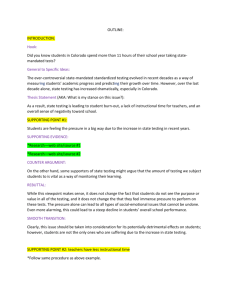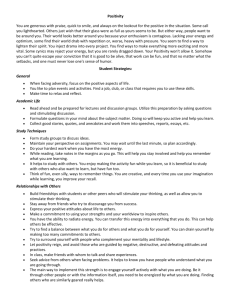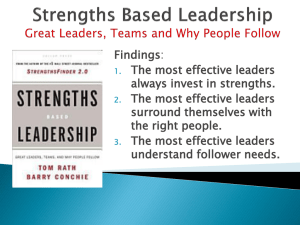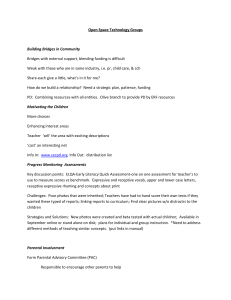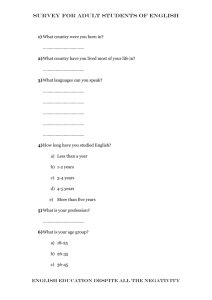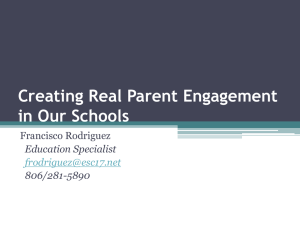The Role of Emotion Socialization in Children`s Response to
advertisement
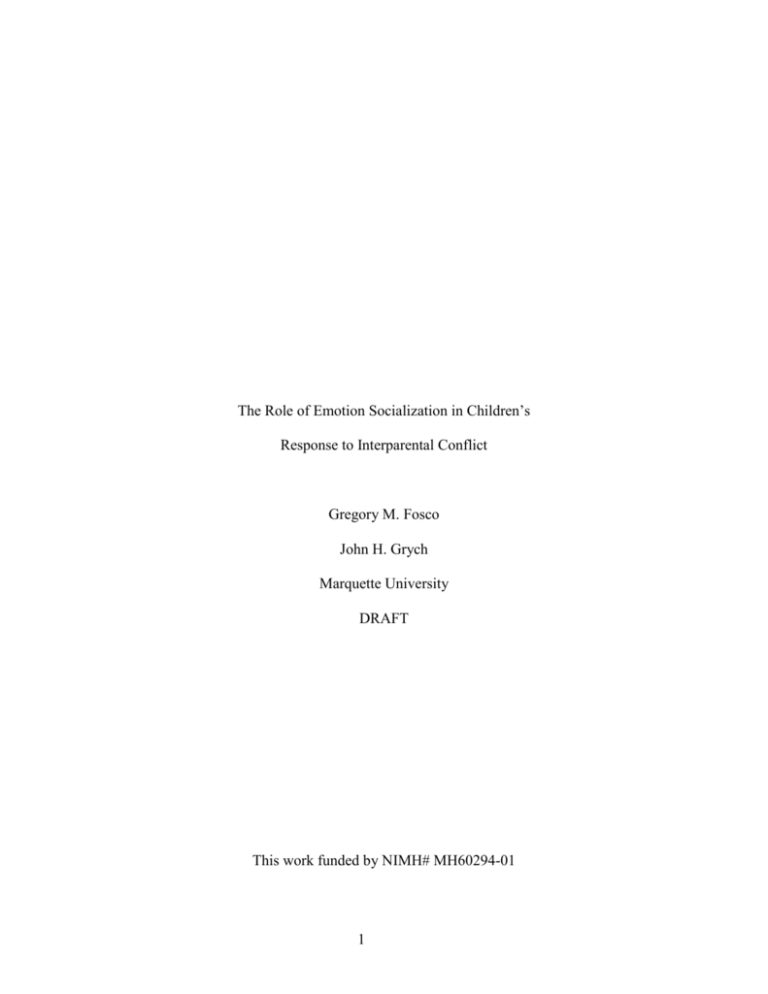
The Role of Emotion Socialization in Children’s Response to Interparental Conflict Gregory M. Fosco John H. Grych Marquette University DRAFT This work funded by NIMH# MH60294-01 1 The Role of Emotion Socialization in Children’s Response to Interparental Conflict Conceptual models seeking to understand the impact of interparental conflict on children have emphasized the mediational roles of cognitive and emotional processes. Children’s perceptions and emotions reflect the meaning of the interaction for children, and are proposed to have implications for their adjustment. The emotional security hypothesis conceptualizes children’s emotional reactions to interparental discord as a sign that the conflict is perceived as a threat to the stability of family relationships (Davies & Cummings, 1994; 1998; Davies, Harold, Goeke-Morey, & Cummings, 2002). Emotions also motivate children’s efforts to restore their security, but repeated incidents of emotional arousal may lead to greater emotional reactivity that undermines children’s functioning (Davies et al, 2002). The specific emotions model (Crockenberg & Forgays, 1996; Crockenberg & Langrock, 2001) emphasizes the need to examine the particular emotions that children experience in response to parental conflict. Children’s emotional reactions result from their appraisals of the impact of the conflict on important goals, and each emotion holds unique meaning. For example, anxiety arises when a goal is threatened whereas sadness occurs when a goal is perceived as lost (Crockenberg & Langrock, 2001). Moreover, the specific emotions framework theorizes that the type of emotional reaction children have in response to conflict leads to specific kinds of adjustment problems. The cognitive-contextual framework conceptualizes children’s emotional reactions as part of the appraisal process (Grych & Fincham, 1990). Appraisals are children’s evaluations of the conflict and are informed by cognitive and affective processes. For example, threat appraisals 2 involve both the perception that something important to the child is at risk and the feeling of fear. Research on the cognitive-contextual framework has shown that appraisals of threat and selfblame in response to parental conflict mediate the association between exposure to conflict and adjustment problems (Grych & Fincham, 1993; Grych et al., 2000; Grych, Harold, & Miles, 2003). Despite this emphasis on the importance of children’s cognitive and emotional reactions to conflict, little is known about how children come to appraise conflict in the ways that they do. The degree of hostility and aggression expressed by parents affects children’s responses, but children vary in their perceptions and emotions even when witnessing identical conflictual interactions. Grych and Fincham (1990) argued that contextual factors such as children’s prior experience with parental discord shape their appraisals of conflict. Several studies have shown that children exposed to more frequent and hostile parental disagreements are sensitized to conflict, exhibiting greater perceived threat and emotional distress when they observe anger and discord between their parents. However, other potential contextual factors have not been studied systematically. Although existing research provides some insight into children’s emotional responses to parental conflict, most studies have focused on interparental conflict in isolation from other family processes. Family systems theory argues that interactions between family members must be understood within the broader context of the family functioning; other aspects of family functioning may affect the meaning and impact of parental disagreements for children. Family systems theory has not been well integrated into the study of parental conflict and child adjustment, but offers considerable promise for developing a richer understanding of the role of conflict in child development. 3 In the present study, we examine broader family factors that may shape how children perceive and respond to conflict. Because conflict typically involves the expression of negative affect, children’s experiences with emotion in the family may be particularly relevant for understanding their response to conflict. To investigate this possibility, we drew on emotion socialization theory, which describes processes by which children learn how to express their emotions and comprehend the emotions expressed by others (Denham, 1998). By integrating ideas from this literature into the study of parental conflict, we hoped to gain new perspectives on dimensions of family functioning that may be particularly important for children’s emotional responses to conflict. Emotion socialization theory identifies three major processes through which emotion socialization occurs in the family: through modeling processes or expressions of emotion, responses to children’s negative affect, and coaching, or talking to children about emotional experiences (Halberstadt, 1991). The present investigation focuses on emotional expression and parental responses to their children’s negative affect. Modeling Affect Expression The way emotions are generally expressed in the family serves as a model for children and provides a backdrop for interpreting particular interactions (Denham, 1998; Tomkins, 1963). It therefore could affect both children’s interpretation of a parental disagreement and their tendency to express their own emotions. For example, an angry parental conflict might be highly salient and upsetting in a family that rarely express negative affect, whereas the same interaction might be seen as normative and less distressing in a family that expresses anger more frequently. Children in the latter family also may be more likely to freely express whatever negative feelings arise, whereas children in the low expression family may try to inhibit their emotional 4 expression. This perspective suggests two possible effects: A contrast effect, whereby conflict in families low in negative emotional expression would be more upsetting than conflict in high negative families, and a disinhibition effect, whereby children in highly negative families would tend to experience and express more negative affect in response to conflict. The latter would suggest that the sensitization effect documented in prior research is not specific to children’s experiences with interparental conflict; rather, negative affect expressed in the family as a whole may sensitize children to hostility between their parents. . Contingency Responses to Children’s Affect Parent’s responses to children’s negative affect expressions also may play a significant role in how children learn to cope and respond to interparental conflict. Parents responses can be supportive by helping the children express their emotions or how to manage their emotions competently. However, parents may also minimize, punish, or become distressed in the face of children’s negative affect, exacerbating children’s distress (Eisenberg & Fabes, 1994). Children whose parents respond supportively to their negative affect tend to have children with greater social peer competence (Eisenberg, Fabes, & Murphy, 1996). Children whose parents tend to help them label, problem-solve, and express their emotions experienced less negative affect in the face of interparental conflict (Katz & Gottman, 1997). Given the importance of children’s distress reactions to interparental conflict, how parents teach children to manage this affect may help us understand how children’s specific emotional reactions may develop into adjustment problems. The Present Study In this study, we seek to integrate these two central dimensions of emotion socialization with the existing process models of interparental conflict. We anticipate that the family 5 emotional climate will influence the meaning children attribute to the conflict they witness and therefore influence the impact of conflict on their adjustment. The first aim of this study is to examine the impact of the general patterns of family emotional expression, which may influence the impact of parental conflict in two ways. In the first pattern, children’s experiences with negative affect in the family may serve to normalize their experience negativity, reducing the salience of parental conflict episodes as they blend into the greater climate of negativity. Such an effect would diminish the unique impact conflict has on children. In the second pattern, the sensitizing pattern, greater levels of family negativity may serve to strengthen children’s maladjustment to parental conflict or increase it. Additionally, family positivity would then contribute to either buffering the effects of conflict, or simply diminish them. The second aim of this study was to examine how parent’s responses to children’s affect responses to conflict affects their levels of distress. We anticipate that parent’s supportive responses to children’s negative affect will be associated with reduced adjustment problems, while unsupportive responses will facilitate greater maladjustment for children. Method Participants Participants were recruited from several local, ethnically diverse elementary schools. Following this recruitment, families were contacted to participate in our study. The sample included 144 families with children (48% girls) in the fourth or fifth grade (median age 10, range 8-12) and whose parents had been living together for at least two years. The sample was culturally diverse, comprised of children who rated themselves as Caucasian (56.7%), African American (25.9%), Latino (6.3%), Asian (1.4%), Biracial (7.0%) and “other” (2.8%). 6 Procedures Families were brought in to our lab for the data collection. Parents and children were given survey packets to fill out independently. In addition, the parents participated in a conflict discussion with the child present in the room. Later, the children watched a recording of the conflict and periodically rated their levels of distress on a standard 6-question affect rating scale. Measures Interparental Conflict. Children’s reports of parental conflict was assessed using the Conflict Properties scale from the Children’s Perceptions of Interparental Conflict Questionnaire, which includes the frequency, intensity and resolution children witness in parental conflict (CPIC; Grych, Seid, & Fincham, 1992). This scale had appropriate reliability (α = .88). Appraisals of Interparental Conflict. To assess children’s appraisals of the parental conflict, the Threat and Self-Blame scales from the CPIC (Grych et al., 1992). The Threat scale measures the level of threat felt by children in conjunction with their perceived ability to cope with the conflict. The Self-Blame scale assesses children’s beliefs that they are at fault for the conflict and the level to which they perceive it to be about them. The Threat and Blame Scales demonstrated adequate reliability (α’s = .78 and .79, respectively). Family Emotional Expressiveness. Mothers and fathers filled out the Self Expressiveness in the Family Questionnaire (SEFQ; Halberstadt, Cassidy, Stifter, Parke, & Fox, 1995). This questionnaire was used to compute Family Positivity and Negativity scales, assessing the degree and frequency parents express positive and negative affect. These scales had adequate reliability for mothers (α’s: positivity = .89 and negativity = .86) and fathers (α’s: positivity = .86 and negativity = .80). Family Positivity and Negativity were computed by summing across mother 7 and father reports of the construct to form two larger scales reflecting the general patterns of emotional expression in the family. Parent’s Responses to Children’s Negative Affect. Mothers and Fathers filled out the Coping with Children’s Negative Affect Scale (CCNES; Fabes, Poulin, Eisenberg, & MaddenDerdich, 2002). This questionnaire provides information about 6 different dimensions of emotional responding, however, given the significant overlap (r’s ranged from .33 to .71, all p’s <.01) these scales were combined to form supportive and unsupportive reactions scales. Due to unreliable internal consistency, mother and father distress response scales were dropped from analyses. All other scales had adequate reliability (α’s ranged from.76 to .87). Children’s Distress. While watching a video of an interparental conflict episode the child had recently experienced, children reported on their feelings of anger, sadness, and worry. Due to high correlations (r = .65 to .73), they were combined to form an overall distress scale. Children’s Psychological Adjustment. Children responded to the Youth Self Report Internalizing and Externalizing scales (YSR; Achenbach, 1991). The Internalizing scale describes the degree to which children report symptoms of anxiety and depression and had adequate reliability (α = .85). The Externalizing scale tapped into children’s reports of aggressive behavior and had adequate reliability (α = .80). Results First, we computed correlations among the variables. As Table 1 shows, interparental conflict was significantly correlated with family positivity and negativity, appraisals, and children’s adjustment. Family positive and negative expressiveness was also related to children’s appraisals, but only positivity was correlated with children’s adjustment. 8 Then, analyses were conducted to determine if different combinations of positive and negative family expressiveness operated differently in the socializing influence on the meaning children took from parental conflict. Four groups were formed using the Self Expressiveness in the Family Questionnaire (SEFQ): high on both positive and negative expressiveness; low on both positive and negative expressiveness; high on positive but low on negative; low on positive but high on positive. The groups expected to be similar on a particular dimension of expressiveness (e.g., high positivity/low negativity and high positivity/high negativity should not be different in positivity, but should be different for negativity) did not differ significantly on the relevant dimensions (see Table 2), and so any group differences can be attributed to the combination of positive and negative expressiveness rather than the level on either dimension taken individually. We then examined whether the groups differed on children’s appraisals of parental conflict using MANOVA. Family affect expression significantly predicted children’s selfblaming appraisals (F (3, 132) = 3.177, p<.05); while interparental conflict was the only predictor of children’s Threat (F (1, 132) = 26.526, p<.01). Tukey’s HSD post hoc analyses indicate that family environments characterized by high levels of negative affect and low levels of positive affect were associated with the higher levels of children’s self-blaming attributions for conflict than all other groups (p’s<.05) but no differences were found between the other three groups. To further investigate the roles that positive and negative affect play in children’s appraisals of parental conflict, we used hierarchical regression analyses to determine whether conflict, positivity and negativity had unique predictions for children’s appraisals. As shown in Table 3, only parental conflict was associated with children’s threat appraisals. However, 9 conflict, family positivity, and family negativity all uniquely predicted children’s self-blaming attributions (β’s = .24, -.19, and .17, respectively; all p’s <.05). We then set out to examine whether family expressiveness moderated the association between exposure to interparental conflict and children’s adjustment. We conducted hierarchical regression analyses to test the main and interaction effects of interparental conflict and family expressiveness on children’s internalizing and externalizing problems. As shown in Table 4, interparental conflict and family positivity had unique direct associations with children’s internalizing problems (conflict β= .25, p<.01; positivity β= -.19, p<.05), while negativity served as a moderator (conflict*negativity β= .24, p<.01). Further analyses indicated that conflict was associated with internalizing problems in families where there were higher levels of negativity (β= .48, p<.01) but not when there were lower levels of negativity (β= .10, ns). Similar results were found for externalizing problems. Also shown in table 4, interparental conflict significantly predicted children’s aggression (β= .22, p<.05), but family positive and negative expressiveness did not. However, the interaction term for negativity and conflict again was significant (β= .24, p<.05), indicating that conflict was associated with aggression in families of higher levels of negativity (β= .51, p<.01) but not in less negative families (β= .09, ns). Because family negativity and positivity predict children’s blame appraisals and their adjustment, we tested whether the moderating influence of negativity on children’s adjustment would be significant when children’s appraisals were factored in the model. Thus, we entered “main effect” variables in the first step, followed by the simultaneous entry of the interaction terms and children’s threat and blame appraisals. As Table 5 demonstrates, the interaction effect of negativity and conflict on children’s internalizing and externalizing problems remained 10 significant even when children’s appraisals were entered into the regression equation. Thus, it would appear that the family environment not only affects children’s appraisals, but also has a unique influence on children’s adjustment in addition to children’s appraisals (See Figures 2 and 3). Turning to the second goal of the study, we examined links between parents’ responses to children’s negative affect and children’s cognitive and emotional reactions to parental conflict. Hierarchical regression analyses were used to test for main effect and interaction effects. None of the scales from the CCNES (mother and father supportive and unsupportive parenting) were related to children’s appraisals or psychological maladjustment. Discussion This study offers a first look at family emotional expressiveness and interparental conflict as separate influences on children’s reactions to parental conflict. The results indicate that the phenomenon of sensitization goes beyond children’s exposure to interparental conflict. Rather than high levels of negative affect normalizing or attenuating the impact of hostile interparental conflict, they appear to magnify the effect of conflict on children. More specifically, when families express higher levels of negative affect, the link between exposure to conflict and maladjustment is much stronger than in families where negative affect is less frequent. Furthermore, positive and negative expressiveness operated somewhat differently. The expression of positive affect worked to diminish children’s self-blaming attributions and reduced the effect of negative expressiveness on these appraisals, and also was related to lower levels of internalizing problems. When they first introduced the cognitive-contextual framework, Grych and Fincham (1990) included a construct similar to family expressiveness that they called the family’s emotional climate as a potentially important contextual factor. However, they did not 11 define it very precisely or assess its potential influence on appraisals. These data suggest that constructs drawn from the emotion socialization literature can flesh out the concept of family climate; specifically, the degree to which negative and positive affect is expressed in the family system is a key barometer that may influence both on children’s appraisals and their adjustment. . In contrast, parents’ responses to children’s displays of negative affect were not correlated with either children’s appraisals or their adjustment. This is surprising, but may suggest that parental sensitivity operates through a different pathway. For example, parent’s responses to children’s negative affect may affect their ability to manage and regulate their emotions. Future research should examine parents’ responses as a predictor of children’s emotion regulation capabilities within the framework of interparental conflict and children’s psychological adjustment. In sum, this study provides further evidence for the value of applying a family systems perspective to the study of interparental conflict. By placing children’s experiences with conflict in the broader context of the family, we are likely to better understand why some children are more distressed by parental discord than others and to be able to identify the mechanisms that lead to child maladjustment. 12 Table 1. Correlations Between Predictor and Outcome Variables 1 2 3 4 5 6 7 8 9 10 11 12 1. IP-Conflict ---2. Threat .54** ---3. Blame .35** .25** ---4. Fam (-) .37** .18* .31** ---5. Fam (+) -.20* -.23* -.24** -.12 ---6. Mom Sup -.12 -.11 -.20* -.15 .28** ---7. Dad Sup .05 .06 -.15 -.09 .32** .29** ---8. Mom Unsup .20* .04 .13 .39** -.17 -.30** -.20* ---9. Dad Unsup .25** .16 .41** .27** -.19* -.22* -.19* .43** ---10. Distress .16 .32** .31** .09 -.11 -.13 -.08 .10 .18 ---11. YSR EXT .31** .09 .37** .14 -.19* -.02 -.11 .07 .17 .13 ---12. YSR INT .31** .35** .40** .03 -.25** -.11 -.08 .11 .12 .38** .63** ---M 12.77 10.33 3.33 89.02 168.17 5.47 5.18 2.90 2.56 0.00 7.54 5.79 SD 6.73 4.70 3.25 21.72 20.60 0.62 0.65 0.69 0.66 2.66 4.50 4.39 Note: *p<.05. **p<.01 IP Conflict = CPIC Conflict Properties Scale; Threat = CPIC Threat Scale; Blame = CPIC Blame Scale; Fam (-) = SEFQ Negative Expressiveness; Fam (+) = SEFQ Positive Expressiveness; Mom and Dad Sup = CCNES mom and Dad supportive response; Mom and Dad Unsup = CCNES Mom and Dad Unsupporitve Responses; Worry, Mad, Sad = Children’s Ratings of Distress to Parental Conflict; YSR EXT = YSR Externalizing Scale; YSR INT = YSR Internalizing Scale. 13 Table 2. MANOVA Comparisons of the Four Groups Means and Standard Deviations by Groups representing combinations of High and Low levels of Positive and Negative Expressiveness (Median Splits of Total Expressiveness) 1 (hi+ hi-) 2 (lo+ lo-) 3 (hi+ lo-) 4 (lo+ hi-) Group Diff? N 30 37 33 37 SEFQ + Total M 154.97 153.23 1,3>2,4** 185.57 183.93 SD 8.75 17.06 9.78 16.63 SEFQ – Total M 74.29 70.70 1,4>2,3** 104.64 105.73 SD 15.69 9.95 11.92 17.26 Note: **p<.01 SEFQ + Total = the sum across mothers’ and fathers’ reports of positive expressiveness; SEFQ – Total = the sum across mothers’ and fathers’ reports of negative expressiveness 14 Table 3. Family Expressiveness and Interparental Conflict Predicting Children’s Appraisals Threat Variables Entered Into Equation Step 1. Direct Effects: CPIC Conflict Properties SEFQ Positivity SEFQ Negativity Step 2. Interaction Effects: Conflict Properties * Positivity Conflict Properties * Negativity β Blame ΔR² .32** .54** -.12 -.04 β .24** -.19* .17* .00 .04 .01 Note: *p<.05. **p<.01 15 ΔR² .18** .00 .00 .03 Table 4. Hierarchical Regression Analyses Examining Positivity and Negativity as Moderators of IPC and Children’s adjustment Variables Entered Into Equation Step 1. Direct Effects: CPIC Conflict Properties SEFQ Positivity SEFQ Negativity Internalizing β ΔR² .11** .25** -.19* -.02 Externalizing β ΔR² .10** .22** -.13 .09 Step 2. Interaction Effects: Conflict Properties * Positivity Conflict Properties * Negativity .09 .22** .05* .05 .23** Decomposing Interactions Hi Negativity (+ ½ SD) Lo Negativity (- ½ SD) .48** .10 .51** .09 Note: *p<.05. **p<.01 16 .05* Table 5. Family Positive and Negative Expressiveness and Children’s Appraisals Predicting Adjustment Problems. Variables Entered Into Equation Step 1. Direct Effects of Predictor Variables: CPIC Conflict Properties SEFQ Positivity SEFQ Negativity Internalizing Externalizing β ΔR² β ΔR² .11** .10** .25** .22** -.19* -.13 -.02 .09 Step 2.: Conflict Properties SEFQ Positivity SEFQ Negativity Conflict Properties * Positivity Conflict Properties * Negativity CPIC Threat CPIC Blame .07 -.12 -.09 .09 .22** .22* .27** .23* -.11 .01 .05 .23** -.15 .27** .48** .10 .51** .09 .15** Decomposing Interactions Hi Negativity Lo Negativity Note: *p<.05. **p<.01 17 .12** Figure 1. SEFQ Groups predicting children’s appraisals of interparental conflict Predicting Threat 12 10 8 6 4 2 0 Low +, Low - Low +, Hi - Hi +, Low - Hi +, Hi - Predicting Blame * 5 4.5 4 3.5 3 2.5 2 1.5 1 0.5 0 Low +, Low - Low +, Hi - Hi +, Low - Hi +, Hi - 18 Figure 2. Family Expressiveness, Interparental Conflcit, and Appraisals Predicting Internalizing Problems. Threat .54** Parental Conflict .22* .07 Internalizing Problems .22** Family Negativity .17* .27** .24** Blame Family Positivity -.19* Note: *p<.05. **p<.01 Path Model using Hierarchical Regression Analyses Parental Conflict = CPIC Conflict Properties Scale; Threat = CPIC Threat Scale; Blame = CPIC Blame Scale; Family Negativity = SEFQ Negative Expressiveness; Fam Positivity = SEFQ Positive Expressiveness; Internalizing Problems = YSR Internalizing Scale. 19 Figure 3. Family Expressiveness, Interparental Conflcit, and Appraisals Predicting Externalizing Problems. Threat .54** Parental Conflict -.15 .23* Externalizing Problems .23** Family Negativity .17* .27** .24** Blame Family Positivity -.19* Note: *p<.05. **p<.01 Path Model using Hierarchical Regression Analyses Parental Conflict = CPIC Conflict Properties Scale; Threat = CPIC Threat Scale; Blame = CPIC Blame Scale; Family Negativity = SEFQ Negative Expressiveness; Fam Positivity = SEFQ Positive Expressiveness; Externalizing Problems = YSR Externalizing Scale. 20 21
